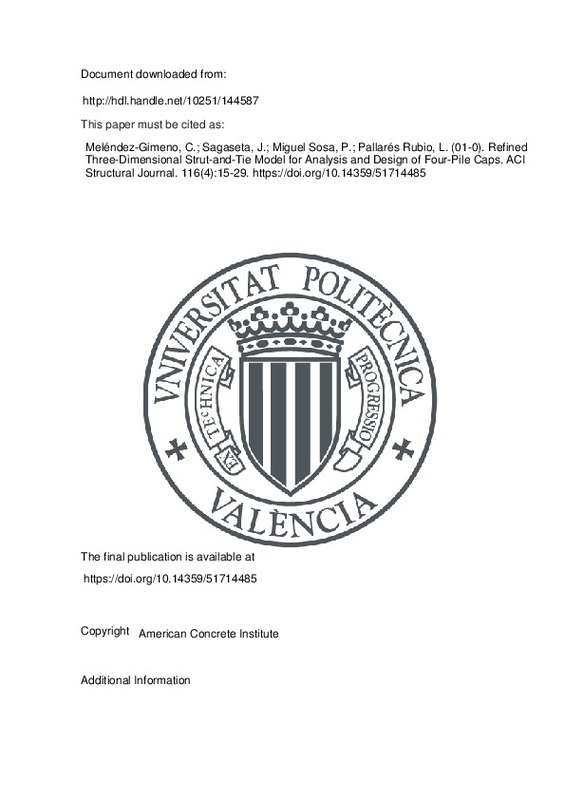JavaScript is disabled for your browser. Some features of this site may not work without it.
Buscar en RiuNet
Listar
Mi cuenta
Estadísticas
Ayuda RiuNet
Admin. UPV
Refined Three-Dimensional Strut-and-Tie Model for Analysis and Design of Four-Pile Caps
Mostrar el registro sencillo del ítem
Ficheros en el ítem
| dc.contributor.author | Meléndez-Gimeno, Carlos
|
es_ES |
| dc.contributor.author | Sagaseta, Juan
|
es_ES |
| dc.contributor.author | Miguel Sosa, Pedro
|
es_ES |
| dc.contributor.author | Pallarés Rubio, Luis
|
es_ES |
| dc.date.accessioned | 2020-05-29T03:33:43Z | |
| dc.date.available | 2020-05-29T03:33:43Z | |
| dc.date.issued | 2019-07-01 | es_ES |
| dc.identifier.issn | 0889-3241 | es_ES |
| dc.identifier.uri | http://hdl.handle.net/10251/144587 | |
| dc.description.abstract | [EN] Pile caps used in foundations are commonly designed for simple cases of loading and geometry using the strut-and-tie method. This approach is known to provide safe designs and rather conservative predictions of the ultimate failure load of tests. This level of conservatism is due mainly to the large simplifications made in the geometry assumed, which in many cases ignore relevant parameters such as the size of the column. A three-dimensional (3-D) strut-and-tie model is presented for four-pile caps in which the geometry adopted is optimized. The inclination of the direct strut from the column to the pile is obtained analytically through the maximization process of the resisting load carried by the truss assuming different modes of failure (flexural and shear). This approach is shown to provide more accurate predictions of the strength of existing deep pile cap tests with lower scatter compared to design approaches in the literature and the ACI 318 Code. | es_ES |
| dc.description.sponsorship | The authors wish to thank the Spanish Ministry of Education for the FPU fellowship FPU12-01459 received by the first author and the funding provided for his research stay at the University of Surrey. The authors also wish to thank the Spanish Ministry of Economy and Competitiveness for funding Project BIA 2012-32300. | es_ES |
| dc.language | Inglés | es_ES |
| dc.publisher | American Concrete Institute | es_ES |
| dc.relation.ispartof | ACI Structural Journal | es_ES |
| dc.rights | Reserva de todos los derechos | es_ES |
| dc.subject | Design | es_ES |
| dc.subject | Discontinuity region | es_ES |
| dc.subject | Finite element analysis | es_ES |
| dc.subject | Pile cap | es_ES |
| dc.subject | Reinforced concrete | es_ES |
| dc.subject | Shear | es_ES |
| dc.subject | Strut-and-tie method | es_ES |
| dc.subject | Three-dimensional | es_ES |
| dc.subject | Truss model | es_ES |
| dc.subject.classification | INGENIERIA DE LA CONSTRUCCION | es_ES |
| dc.title | Refined Three-Dimensional Strut-and-Tie Model for Analysis and Design of Four-Pile Caps | es_ES |
| dc.type | Artículo | es_ES |
| dc.identifier.doi | 10.14359/51714485 | es_ES |
| dc.relation.projectID | info:eu-repo/grantAgreement/MINECO//BIA2012-32300/ES/ESTUDIO EXPERIMENTAL Y NUMERICO DE REGIONES D TRIDIMENSIONALES DE HORMIGON ARMADO: ENCEPADOS Y CALICES/ | es_ES |
| dc.relation.projectID | info:eu-repo/grantAgreement/MECD//AP2012-1459/ES/AP2012-1459/ | es_ES |
| dc.rights.accessRights | Abierto | es_ES |
| dc.contributor.affiliation | Universitat Politècnica de València. Departamento de Ingeniería de la Construcción y de Proyectos de Ingeniería Civil - Departament d'Enginyeria de la Construcció i de Projectes d'Enginyeria Civil | es_ES |
| dc.description.bibliographicCitation | Meléndez-Gimeno, C.; Sagaseta, J.; Miguel Sosa, P.; Pallarés Rubio, L. (2019). Refined Three-Dimensional Strut-and-Tie Model for Analysis and Design of Four-Pile Caps. ACI Structural Journal. 116(4):15-29. https://doi.org/10.14359/51714485 | es_ES |
| dc.description.accrualMethod | S | es_ES |
| dc.relation.publisherversion | https://doi.org/10.14359/51714485 | es_ES |
| dc.description.upvformatpinicio | 15 | es_ES |
| dc.description.upvformatpfin | 29 | es_ES |
| dc.type.version | info:eu-repo/semantics/publishedVersion | es_ES |
| dc.description.volume | 116 | es_ES |
| dc.description.issue | 4 | es_ES |
| dc.relation.pasarela | S\391640 | es_ES |
| dc.contributor.funder | Ministerio de Economía y Competitividad | es_ES |
| dc.contributor.funder | Ministerio de Educación, Cultura y Deporte | es_ES |







![[Cerrado]](/themes/UPV/images/candado.png)

